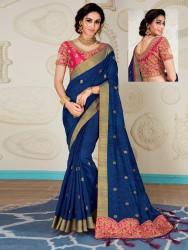Sarees invariably happen to be the most common attire for women in India. Sarees also happen to be the traditional dress code for every Indian woman as they are mostly witnessed wearing them on all traditional events. Sarees are quite synonymous and common for every woman. The tracing of the origin or the advent of saree as a dress and
costume for women may be difficult, but the significance and utility even today has enormous emotional value attached for every woman. Every teenager girl dream of wearing a saree at some point of their life and she often glamourizes herself in the attire, many teenage girls are also seen trying their looks by amateurishly wearing sarees which would often end up with their squirmish giggles when caught wearing them. The dress attire is sanctimoniously worn across the length and breadth of this country, it is worn as a special attire for functions,
festivals, rituals, ceremonies and puzzlingly on occasions which doesn’t have much significance – even on day-to-day basis while doing daily mundane chores. This factor completely propels the attire into magnanimous heights, since the attire has carved itself a niche and a very special place in every women’s heart.

The never-ending fad of sarees
The fad of sarees is a never-ending one, sarees are meant specially for women as it enhances the beauty and exquisiteness in every woman. Women wearing sarees simple look outstanding, diplomatic and extravagantly beautiful. Hence, even today the fad is phenomenally growing, and every teenager still glamourizes wearing them. The fashion of sarees is here to stay for a longer period than anticipated as the fad has created tremendous interest and longing in most women. Indian cinema extravagantly boasts sarees worn by the screen divas. Bollywood and its other paraphernalia’s like Tollywood, Kollywood, Sandalwood and Mollywood also have their fragments woven into the magnum-opus story of the great Indian cinema and its historic association with sarees. Anybody visualizing through the by lanes of their memory can invariably see the heroine dancing in the rains wearing a saree. Every heroine of Indian cinema would love to perform a role of this kind, the reason being the dramatic effects and ripples
that the scene has created over the years – it does have a historical significance and impact on every Indian.
The journey and the variety of sarees
Tracing the evolution and origin of sarees is almost impossible as the fashion has a dated history of over 5000 years of existence, the Indian saree is considered to be among the oldest form of attire and garment in the world which is still in existence. The mentioning of sarees could be found in the Vedas and the Indus Valley Civilization, the fact of it being the ancient has never impacted on its popularity. The saree could be still witnessed on many major ramp walks and the fashion shows. The fad has its ardent followers in teenagers, hip-hop college students, working women professionals and conservative grandmothers, the very culture of this land is deeply embedded and woven in the fabric. There are more than 80 variants in sarees, there’s the pleat less Bengali, Odisshi and Kodagu styles, and then there’s the two-piece Malayali style and the other regional contexts and connects. There also variations in the way the fabric is woven, there’s the tie- dye Bandhani sarees, Chanderi cotton sarees, Sambalpuri saree, Tant saree, Khadi saree, Dhakai saree, Chikankari saree, Gadwal saree, Pochampalli saree and the Kota Dorai saree. The silk ones have their own variants with names, the Banarasi, Kancheepuram and Mysore silk sarees have all earned a name of repute eventually making the attire a strong proponent of Indian culture.
